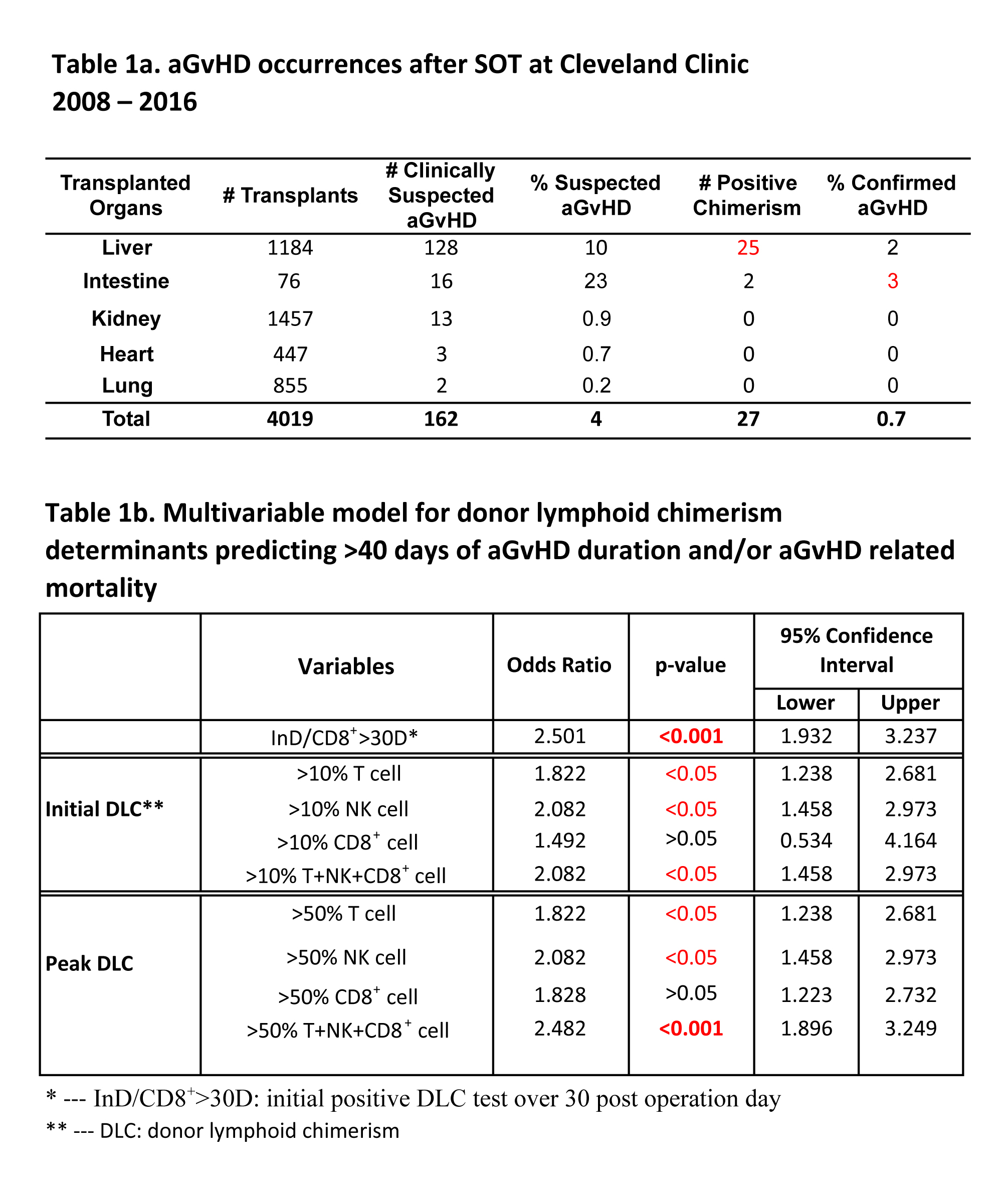Donor Lymphoid Chimerism in Early Recognition and Prediction of Clinical Outcome Caused by Acute Graft versus Host Disease After Solid Organ Transplant.
1Cleveland Clinic, Allogen Laboratories, Cleveland, OH
2Avalon University School of Medicine, Willemstad, Netherlands Antilles
3Baylor University Medical Center, Dallas, TX
4Transplantation Center, Cleveland Clinic, Cleveland, OH
5Transplantation Center, University of Chicago, Chicago, IL
Meeting: 2017 American Transplant Congress
Abstract number: A37
Keywords: Intestinal transplantation, Liver, Lymphocyte activation, Mortality
Session Information
Session Name: Poster Session A: Cellular & Bone Marrow Transplantation Session I
Session Type: Poster Session
Date: Saturday, April 29, 2017
Session Time: 5:30pm-7:30pm
 Presentation Time: 5:30pm-7:30pm
Presentation Time: 5:30pm-7:30pm
Location: Hall D1
Introduction: Acute graft versus host disease (aGvHD) after solid organ transplant (SOT) is rare but related with high mortality. Early accurate diagnosis is critical for disease management. This study aims to identify donor lymphoid chimerism (DLC) pattern in SOT to better predict clinical outcome of aGvHD.
Method: 162 out of 4019 SOT recipients (2008-2015) with clinical aGvHD symptoms were tested for DLC by short tandem repeat assay using T, NK, and CD8+ cells. Individuals with DLC≥5% in CD8+ within 100 post operation days (POD) were confirmedas aGvHD. The variables of DLC determinants were: initial +DLC in CD8+>30 POD (InD/CD8+>30D); initial DLC>10% in T, NK, CD8+, and T+NK+CD8+; peak DLC>50% in T, NK, CD8+, and T+NK+CD8+; Clinical outcome was determined by >40 days of aGvHD duration and/or aGvHD related mortality (>40D Du/M). Logistic regression was used to analyze >40D Du/M to the response of DLC determinants.
Results: aGvHD was not identified in kidney, heart, and lung recipients. Liver and intestine recipients each demonstrated the highest absolute number (liver, N=25) and percentage (Intestine: 3%) of aGvHD, respectively (Table 1a). +DLC was prevalent in CD8+ cells in the initial phase of detection, but had no significant relationship with >40D Du/M. There was a mildly remarkable association of initial DLC>10% and peak phase DLC>50% in each T and NK cell to >40D Du/M. Both InD/CD8+>30D and peak phase DLC>50% in T+NK+CD8+ were significantly associated with >40D Du/M(Table 1b).
Conclusions: Initial +DLC in CD8+ cell is a sensitive indicator of aGvHD. Both delayed diagnosis of InD/CD8+>30D and peak phase DLC>50% in T+NK+CD8+ strongly predicts aGvHD related negative impact following SOT.
CITATION INFORMATION: Zhang A, Sun Y, Hashimoto K, Fujiki M, Askar M, Fung J, Miller C, Abu-Elmagd K, Eghtesad B. Donor Lymphoid Chimerism in Early Recognition and Prediction of Clinical Outcome Caused by Acute Graft versus Host Disease After Solid Organ Transplant. Am J Transplant. 2017;17 (suppl 3).
To cite this abstract in AMA style:
Zhang A, Sun Y, Hashimoto K, Fujiki M, Askar M, Fung J, Miller C, Abu-Elmagd K, Eghtesad B. Donor Lymphoid Chimerism in Early Recognition and Prediction of Clinical Outcome Caused by Acute Graft versus Host Disease After Solid Organ Transplant. [abstract]. Am J Transplant. 2017; 17 (suppl 3). https://atcmeetingabstracts.com/abstract/donor-lymphoid-chimerism-in-early-recognition-and-prediction-of-clinical-outcome-caused-by-acute-graft-versus-host-disease-after-solid-organ-transplant/. Accessed December 9, 2025.« Back to 2017 American Transplant Congress
